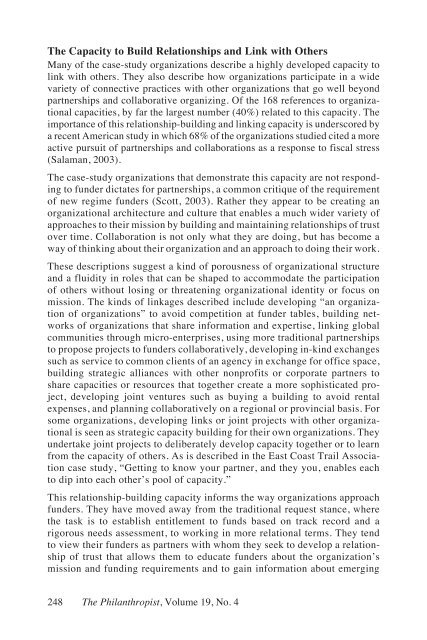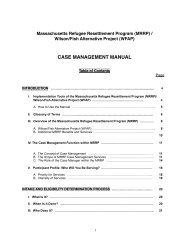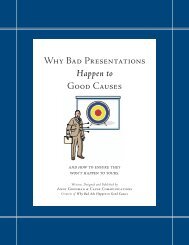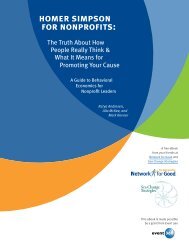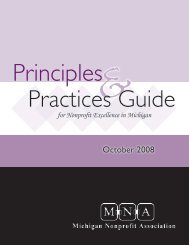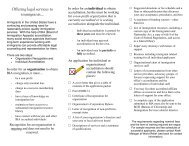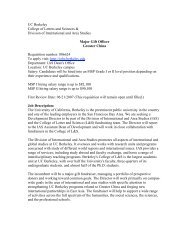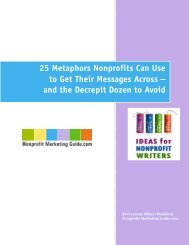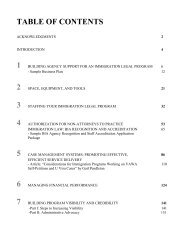Print this article - The Philanthropist
Print this article - The Philanthropist
Print this article - The Philanthropist
You also want an ePaper? Increase the reach of your titles
YUMPU automatically turns print PDFs into web optimized ePapers that Google loves.
<strong>The</strong> Capacity to Build Relationships and Link with Others<br />
Many of the case-study organizations describe a highly developed capacity to<br />
link with others. <strong>The</strong>y also describe how organizations participate in a wide<br />
variety of connective practices with other organizations that go well beyond<br />
partnerships and collaborative organizing. Of the 168 references to organizational<br />
capacities, by far the largest number (40%) related to <strong>this</strong> capacity. <strong>The</strong><br />
importance of <strong>this</strong> relationship-building and linking capacity is underscored by<br />
arecentAmericanstudyinwhich68%oftheorganizationsstudiedcitedamore<br />
active pursuit of partnerships and collaborations as a response to fiscal stress<br />
(Salaman, 2003).<br />
<strong>The</strong> case-study organizations that demonstrate <strong>this</strong> capacity are not responding<br />
to funder dictates for partnerships, a common critique of the requirement<br />
of new regime funders (Scott, 2003). Rather they appear to be creating an<br />
organizational architecture and culture that enables a much wider variety of<br />
approaches to their mission by building and maintaining relationships of trust<br />
over time. Collaboration is not only what they are doing, but has become a<br />
way of thinking about their organization and an approach to doing their work.<br />
<strong>The</strong>se descriptions suggest a kind of porousness of organizational structure<br />
and a fluidity in roles that can be shaped to accommodate the participation<br />
of others without losing or threatening organizational identity or focus on<br />
mission. <strong>The</strong> kinds of linkages described include developing “an organization<br />
of organizations” to avoid competition at funder tables, building networks<br />
of organizations that share information and expertise, linking global<br />
communities through micro-enterprises, using more traditional partnerships<br />
to propose projects to funders collaboratively, developing in-kind exchanges<br />
such as service to common clients of an agency in exchange for office space,<br />
building strategic alliances with other nonprofits or corporate partners to<br />
share capacities or resources that together create a more sophisticated project,<br />
developing joint ventures such as buying a building to avoid rental<br />
expenses, and planning collaboratively on a regional or provincial basis. For<br />
some organizations, developing links or joint projects with other organizational<br />
is seen as strategic capacity building for their own organizations. <strong>The</strong>y<br />
undertake joint projects to deliberately develop capacity together or to learn<br />
from the capacity of others. As is described in the East Coast Trail Association<br />
case study, “Getting to know your partner, and they you, enables each<br />
to dip into each other’s pool of capacity.”<br />
This relationship-building capacity informs the way organizations approach<br />
funders. <strong>The</strong>y have moved away from the traditional request stance, where<br />
the task is to establish entitlement to funds based on track record and a<br />
rigorous needs assessment, to working in more relational terms. <strong>The</strong>y tend<br />
to view their funders as partners with whom they seek to develop a relationship<br />
of trust that allows them to educate funders about the organization’s<br />
mission and funding requirements and to gain information about emerging<br />
248 <strong>The</strong> <strong>Philanthropist</strong>, Volume 19, No. 4


